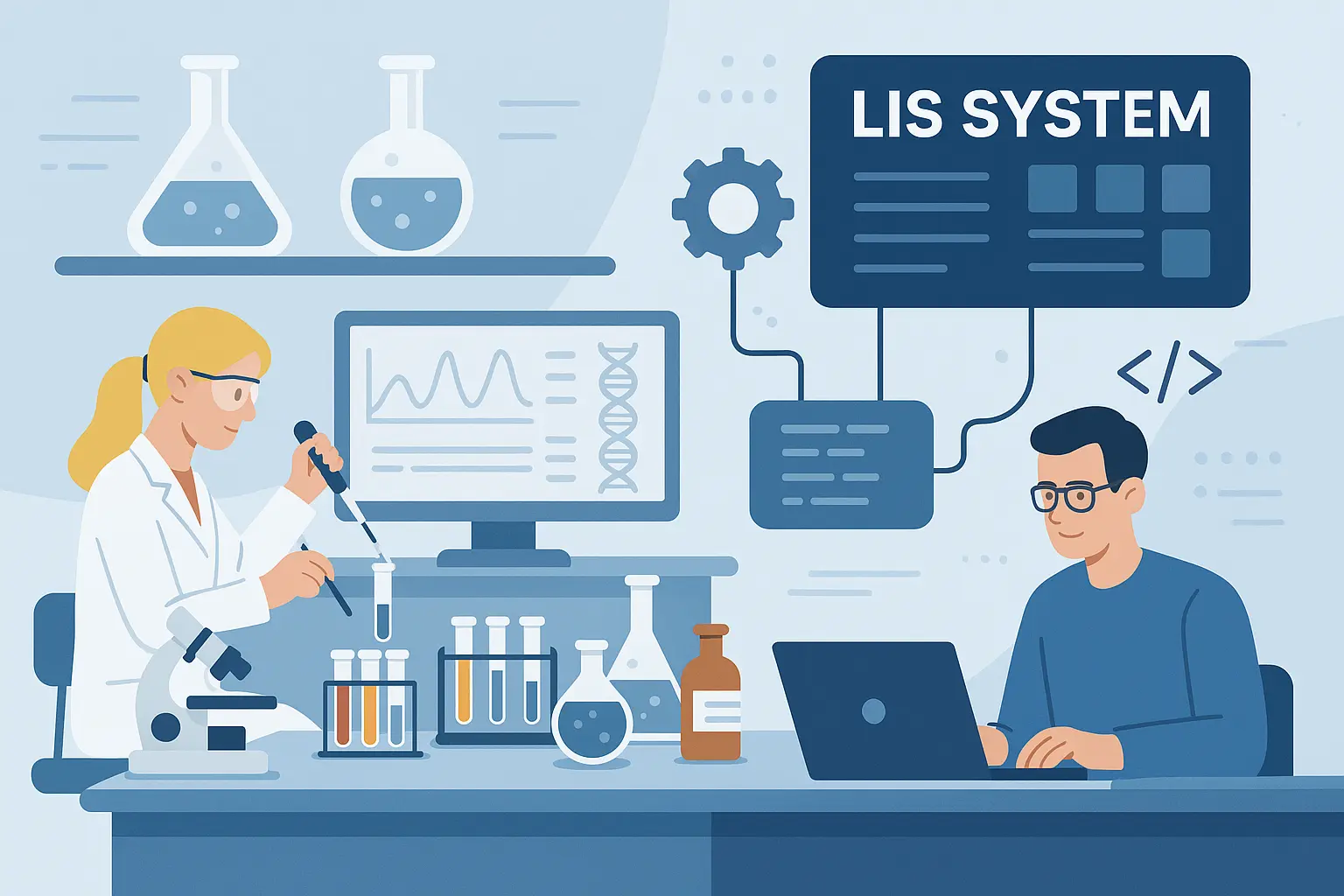Blog
Why Integrated LIS System and Lab RCM Software is a Catalyst for Growth
December 19, 2024
Laboratory medicine is hard enough these days as clinical labs and pathology practices attempt to successfully navigate major external threats like staffing challenges, reimbursement cuts, customer turnover, and constantly changing regulatory requirements.
Learn More: The FDA’s Final Rule on LDTs and What it Means for Independent Medical Labs
To rise above the challenges and succeed where others fail, knowledgeable lab directors and managers are turning toward innovative and operationally efficient laboratory software systems that fully integrate all laboratory information system (LIS) and laboratory revenue cycle management (lab RCM) functions.
In this blog post, we’ll first explain the major drawbacks that medical labs experience while deploying fragmented laboratory information systems and laboratory billing solutions as part of their pathology lab management plan. After that, we’ll highlight how embracing an integrated LIS system and lab RCM platform can propel medical laboratories to new heights of growth and profitability.
Case Study: Leveraging LIS System & Lab RCM Integration to Improve the Laboratory Billing Process

How Data Silos in Laboratory Software Systems Negatively Impact Operational Efficiency, Accuracy, Compliance, and Revenue
Those employed by a lab using two disparate pathology lab software systems to manage medical LIS and lab revenue cycle management workflow already know how frustrating this misaligned arrangement is. For those unfamiliar, here’s a summary of the typical issues with such an arrangement.
Vendor Differences and Workflow Inefficiencies: If the LIS system and the laboratory billing system have been developed independently by different lab vendors using unique data formats or proprietary technologies, it’s a good bet that the interface between the two systems will not be seamless or comprehensive. This will result in data silos, data transfer delays, the need to synchronize master files (providers, insurances, tests, patient demographics, etc.), and questionable data integrity as the patient and specimen information flows from the LIS system to the lab billing system.
Lack of Interoperability: Interoperability standards often differ across laboratory software systems, leading to data transfer bottlenecks that require constant synchronization between systems. This challenge is exacerbated by insufficient APIs or outdated systems that cannot support the latest technology. Furthermore, while the HL7 standard is widely used for data exchange in healthcare, it’s not ideal for transferring billing data due to its limitations in handling complex financial transactions. Ensuring seamless integration and data flow remains critical in maintaining efficient laboratory operations.
Data Mismatch and Errors: The inconsistent data flowing between medical LIS and laboratory revenue cycle management workflow often results in discrepancies in patient information, test codes, and other critical billing details. These inaccuracies can lead to errors in billing statements and insurance claims, causing rejections, delayed payments, and a need for manual corrections. Such issues increase the administrative workload—especially challenging in a market where finding and affording qualified staff is difficult—and directly impact the lab’s ability to collect revenue efficiently. This cascade of inefficiencies can hinder the lab's financial stability and operational effectiveness.
Technical Limitations: Older medical LIS or laboratory billing system interfaces often don’t have the scalability and technical capacity to manage large volumes of shared data effectively. This can necessitate further investment in technology upgrades, or additional software and integration efforts to address these limitations, creating more data silos. Minus such improvements, laboratories may struggle to keep pace with growing data demands, impacting their ability to operate efficiently and remain competitive in a rapidly evolving industry.
Compliance Risks: Accurate lab revenue cycle management is crucial for remaining compliant with all healthcare and billing regulations. Inaccuracies in data exchange between two separate software systems will put the laboratory billing process and the business at risk, opening the potential for billing for services denied, or resulting in audits, penalties, and a huge damage to reputation.
Transparency and Visibility: Separate systems can create “black boxes” where visibility into operations is limited, often resulting in data silos and communication breakdowns. An HL7 integration between systems is the same as trying to connect two rooms through a keyhole, providing only a narrow view of what’s happening. In contrast, a unified platform is like a giant room where the RCM module sees everything happening in technical operations. This transparency ensures that all data is accessible and visible, allowing for real-time decision-making and operational insight. The comprehensive view maximizes efficiency and automation, reduces errors, and ensures that nothing falls through the cracks.
Maintenance and Upgrades: Continuous maintenance and updates are crucial for seamless communication between an interfaced medical LIS and lab RCM system. This process can be costly and complex, particularly when the systems are from different lab vendors or built on independent technology platforms. However, on a unified system, updates to master files—such as CPT codes, fee schedules, diagnostic codes, and insurance payer rules—can be efficiently managed. The LIS and RCM modules within the unified platform receive synchronized updates, eliminating discrepancies and reducing the administrative burden. This streamlined approach enhances operational efficiency, minimizes errors, and supports the lab’s ability to adapt quickly to regulatory and industry changes.
Training and Usability Issues: Managing day-to-day operations with two interfaced systems requires significant training from multiple software lab vendors. If the user interface is not intuitive, it can lead to increased errors, reduced efficiency, lost revenue, and heightened frustration among staff. Even with ongoing conversations with lab vendors, robust data validation practices, and a lab-wide commitment to training, these efforts typically aren’t enough to drive substantial growth and profitability.

Why Modern Labs are Embracing Integrated Laboratory Information System and Lab Revenue Cycle Management Platforms
As you’ll soon see, a unified laboratory information system and lab revenue cycle management informatics platform is more than just a technological upgrade; it's a strategic decision that can set a laboratory on a desired trajectory of operational excellence and sustained growth.
Here’s a summary of the top benefits experienced by labs that chose to modernize and digitally transform their operations.
Streamlined Operations: A single-source informatics platform eliminates the need for multiple, disjointed laboratory software systems (and multiple lab vendors). Patient and specimen data flows seamlessly between aligned functions housed within one united system, reducing manual data transfers, minimizing errors, and speeding up operational and financial processes.
Data Integrity and Security: Data is the lifeblood of a modern laboratory. A single-source all-in-one platform ensures that patient and operational data is consistent across the board. Moreover, it’s easier to enforce robust data security measures on one integrated system than on multiple standalone systems for LIS system and lab billing functions.
Enhanced Financial Health: Integrating a lab’s LIS system with lab RCM workflow ensures that lab billing and reimbursements are directly linked to patient testing data. Automated billing and claims submission reduce human errors and ensure timely reimbursements, bolstering a lab's cash flow and overall financial health.
Real-time Insights: An integrated pathology software (medical LIS and lab RCM) offers the advantage of real-time analytics, from which a lab can gain immediate insights into operations, from turnaround times to financial metrics, allowing for swift decision-making and better business practices.
Scalability: As a laboratory grows, its operations become more complex. A unified LIS system and lab RCM platform can scale to accommodate this growth, from handling increased data volumes to expanding into new test areas.
Optimized Resource Utilization: A unified platform allows laboratories to optimize their resources by reducing the need for multiple system management and training. Staff can focus on core laboratory tasks rather than technical issues and manual data entry. This streamlined approach enhances productivity and allows labs to maximize the value of their workforce.
Improved Compliance: Regulatory compliance is a must for every diagnostic lab. A unified lab information system and laboratory billing solution can be easily updated to keep pace with evolving regulations, ensuring compliance while reducing the administrative burden of manual updates on multiple systems.
Focused IT Support: Instead of spreading IT resources thin over multiple systems, a lab can concentrate on optimizing and supporting a single informatics platform, leading to quicker issue resolution and expedited LIS system and lab billing enhancements.
Enhanced Patient and Client Experience: Billing errors or test results delays can negatively impact a lab’s reputation. An integrated informatics platform ensures timely and accurate communication with patients and healthcare providers, which leads to more satisfaction and trust.
Cost Savings: Maintaining more than one system is costly. There's the financial aspect of licensing multiple products and the operational costs associated with training staff on different systems. Consolidating all this onto a single informatics platform can yield significant cost savings.
Future-Proofing: Software technology and healthcare are both fast-evolving sectors. By committing to a unified LIS system and Lab RCM platform, a lab will be better positioned to integrate new technological advancements such as AI, machine learning, or next-generation sequencing.
Learn More: How AI Can Propel Medical Laboratories into a New Era of Growth

Future Prosperity Starts With a Unified LIS System and Lab RCM Platform
As negative trends continue and the need for quicker, more precise diagnoses increases across the industry, laboratory leaders must move away from the traditional multi-vendor and multi-system setups and embrace the transformative power of one unified informatics platform.
Modern all-in-one medical LIS and lab billing systems come with peak efficiency and they also support process improvement and highly automated clinical laboratory management across multiple departments.
Learn More: Four Game-Changing Business Strategies to Improve Laboratory Processes
Learn More: How Billing and Coding Automation Increases Laboratory Revenue
As the healthcare sector becomes more data-driven and patient-centric, medical laboratories that leverage laboratory information system companies like LigoLab that offer integrated informatics platforms will be the frontrunners, leading the charge in innovation, efficiency, and patient care.
LigoLab’s Principle of Extreme Ownership
Here’s one more important point concerning LigoLab, a leading producer of unified medical LIS and lab RCM platforms.
Unlike separate systems where lab vendors often resort to finger-pointing, LigoLab operates on a principle of extreme ownership. The pathology lab software company takes full responsibility for all issues related to the medical LIS or lab RCM systems. This commitment ensures that problems are addressed swiftly and effectively, without delays or miscommunication. LigoLab empowers laboratories to operate more efficiently and focus on achieving their growth objectives by providing a unified platform and a dedicated team focused on resolving challenges
A Pathology Software Leader and True Lab Partner
LigoLab is a leading provider of innovative and comprehensive pathology lab software for diagnostics laboratories, offering advanced lab information systems (LIS systems), lab revenue cycle management (lab billing), and direct-to-consumer lab testing (TestDirectly) solutions on one unified informatics platform.
LigoLab digitally transforms pathology groups and clinical labs into modern and efficient organizations that are more productive and more profitable. To learn more, click the link below or contact a LigoLab Product Specialist.
Learn More: Navigating the Future of Pathology: The LigoLab Advantage






